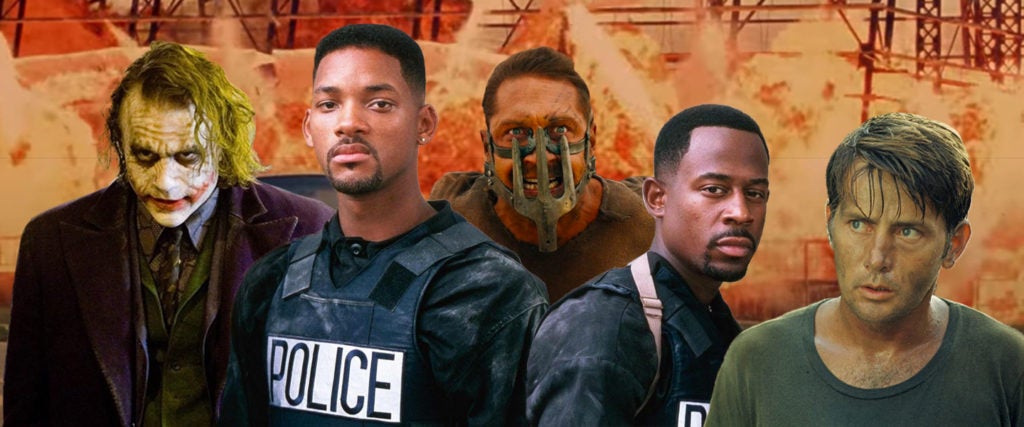“Where’s the kaboom? There was supposed to be an earth-shattering kaboom!” — Marvin the Martian
It’s looking more and more like 2020’s summer movie season is going to be severely curtailed, if not postponed outright. Some of the year’s most-anticipated blockbusters (like Black Widow and No Time to Die) have been bumped to the fall, while others (like Fast & Furious 9 and Ghostbusters: Afterlife) are now set for the summer of 2021. Arguably the biggest film left on the summer schedule is Christopher Nolan’s mysterious, time-bending cat-and-mouse thriller Tenet, which is still slated — for now, anyway — for a July 17th theatrical release.
If Tenet does arrive as planned, we can look forward to enjoying at least one of the grand summer movie traditions: watching a director explode something massive. As seen in the Tenet trailer, at some point in this picture, a jumbo jet will smash into a building and burst into flames. Nolan is an old-school type who prefers practical effects to digital when possible, so he reportedly blew up an actual Boeing 747 for this shot: in part because sometimes it’s actually more cost-effective to destroy something real than to find a way to fake it, and in part because doing so is usually cooler than blowing up a model.
Since the dawn of motion pictures, spectacle has been as much an element of cinema as storytelling or aesthetics. And while the nature and the execution of the spectacular has changed over time, one constant is that real explosions have a unique appeal. Model-work, matte-work and CGI are all nifty in their own way, but the logistics and the visual impact of a big blast have a fascinating, almost documentary-like quality. We can watch these movies even decades later and witness something that actually happened.
There’s always some trickery involved with filmmaking, so we’re not claiming the movie explosions listed below were wholly devoid of special effects enhancements. We should also acknowledge that in some of these cases, the crew built something huge just to wreck it. Still, in each example, we’re ultimately talking about real buildings, real vehicles and real bridges (and aquariums and jungles and fireworks warehouses).
With all of that said, here are some of the most spectacular movie explosions, subdivided by category. (Hat-tip to the YouTube channel X-Plode Cinema, from whence many of the attached clips come.)
Vehicles
The General (1926). Let’s start by giving a nod to the mother of all boldly destructive movie stunts. Often cited as the most expensive single shot of the silent movie era, the wreck of the title locomotive in Buster Keaton’s Civil War comedy The General reportedly cost between $40,000 and $50,000, and involves a burning bridge — rigged to collapse — as well as the wreck of an actual train, which plunges into the water in a riot of steam and flame. This may not be the most explosive scene on this list, but it did set the standard for the subsequent century of cinematic mayhem.
Bad Boys (1995). Nolan isn’t the first filmmaker to blow up an airplane. Michael Bay has spent a good chunk of his career staging huge explosions — usually with his heroes fleeing the fireball. Bay debuted with the relatively modestly budgeted buddy cop picture Bad Boys, which climaxes with a 727 exploding inside of a blimp hangar at Miami’s Opa-Locka Airport. Mike Meinardus (the pyrotechnics expert who’d previously worked on Speed) helped rig the blast, putting an exclamation point at the end of Bay’s first big introduction to the multiplex: an over-the-top shoot-‘em-up where hardly any vehicle or building survives unscathed.
Speed (1994). Speaking of Speed — and speaking of planes — one of the best action movies of the 1990s pits a decommissioned cargo jet against an L.A. city bus, in a head-on collision. Nobody wins… except the audience. Though set at LAX, the scene was shot at Mojave Airport, out in the desert, where filmmakers could destroy things without bothering too many people nearby. This is a recurring theme in carnage-heavy blockbusters: It’s always easier to make them in places where no one minds the occasional megaton blast.
Mad Max: Fury Road (2015). We’ve had trains and planes, so it’s time for an automobile… or whatever you want to call the armored vehicles in Fury Road. Director George Miller’s action choreography in this movie is so intricate — and the editing so rapid-fire — that it’s hard from second to second to tell exactly what’s exploding. But during one of the most intense of the nearly wall-to-wall chase sequences, the Mad Max version of an oil-filled tanker goes boom, all while multiple souped-up cars and trucks speed alongside — some of them with drivers and hangers-on fully exposed to the elements, swaying back and forth on poles. Watching this scene is like watching a three-ring circus, but on wheels, in the Namib desert, with bombs going off all around.
Buildings
Zabriskie Point (1970). Superficially, this elliptical Michelangelo Antonioni art film wouldn’t seem to have much in common with the slam-bang blockbusters in this list. But one could argue that circa 1970, the counterculture and the avant-garde had practically become the mainstream in Hollywood. And one of the things that brought curious audiences to the art house in the Nixon era was, yes, the spectacle: Be it explicit nudity, mind-bending sci-fi or a bit of the old ultra-violence. None of this was enough to make the slow and moody Zabriskie Point into a box-office smash. But Antonioni did have the excess of the era in mind when he blew up a stylish beachfront house at the movie’s end — showing the detonation over and over from different angles for nearly five minutes, and lovingly filming the consumerist debris to the trippy sounds of Pink Floyd.
The Dark Knight (2008). As much as Nolan likes to tell stories of rich narrative complexity and philosophical depth, he also seems to genuinely enjoy making things go kablooie. As part of the gritty realism of Nolan’s Batman movies, his crew leaned heavier than most superhero stories on practical effects, helping to make those films more disturbingly weighty. The best case-in-point comes in The Dark Knight, where Heath Ledger’s unsettlingly down-to-earth version of the psychotic, clown-faced supervillain “the Joker” blows up a Gotham City hospital (which was in reality an abandoned Brach’s candy factory in Chicago). The moment is at first darkly funny — as this madman gets irritated by his faulty trigger — and then becomes chilling as Nolan pulls back to show an ordinary city block being consumed by an actual explosion.
Spectre (2015). Eat your heart out, Buster Keaton: According to The Guinness Book of World Records, when this James Bond production sent pieces of a Moroccan communications center flying every which-a-way, the explosive stunt became the “largest” ever filmed. For a series that’s relied on splashy moments since its 1962 debut, that’s quite a feat. It’s also quite an explosion: A large-scale detonation that starts with a few smaller conflagrations and then ends with Daniel Craig’s Bond watching an entire domed building go up, giving the disaster a casual glance so cool that he could probably put out the fire with his attitude.
Police Story 2 (1988). It’d be a crime to put together a list about massive movie destruction and not include Jackie Chan. Although Police Story 2 isn’t as much of a must-see as its predecessor, it does feature a few fantastic action sequences, including a big final fight in a fireworks warehouse. Inevitably, the goods inside go off, with sparks shooting by our hero as he barely escapes with his life. The scene ends with the ramshackle old depot collapsing in mighty blaze — with still more curlicues from the fireworks, slowed down so the audience can appreciate the show.
Random Stuff
Mission: Impossible (1996). In the 1980s and 1990s, Hollywood action movies introduced the now clichéd image of tough guys and gals running to safety (or, if they’re total badasses, walking) while the frame behind them fills with flame. In the first Mission: Impossible movie, director Brian De Palma replaces the fire with water: an overpowering wave, which washes through a fancy, aquarium-filled Prague restaurant after Tom Cruise’s Ethan Hunt uses a handy little plastic explosive to shatter the tanks. Cruise himself reportedly had the idea for the set-piece, and he did the stunt himself — of course — even though the gallons of water falling from the ceiling and smashing through the front windows of the restaurant were, in a way, more dangerous than any inferno.
Apocalypse Now (1979). Shooting Apocalypse Now in the Philippines caused a lot of problems for director Francis Ford Coppola, whose cast and crew were bedeviled by the heat, the heavy rains and the generalized madness of a seemingly endless production. One of the advantages of the location, though? The local authorities gave Coppola wide latitude to blow stuff up. Easily the most famous explosion in Apocalypse Now is the “I love the smell of napalm in the morning!” bombing run, where a whole line of trees at the mouth of a river goes up in flames. The image is so arresting and so eerie that Coppola used an alternate take from the scene to open the movie, setting the tone for the kind of film this was going to be.
The Bridge on the River Kwai (1957). Since we began with The General, we may as well end with The Bridge on the River Kwai. Both feature splashy scenes where a train wrecks while crossing a collapsing bridge. But the former is more about the train, while the latter… well, the emphasis is right there in the title. What makes Kwai’s climactic smasheroo all the more impressive is that we’ve seen the bridge being built, slat-by-slat and post-by-post, by British POWs who’ve done their best to make their Japanese captors proud. There are ironies aplenty for the audience to contemplate, if they like. But no one should judge the crowd too harshly if they just want to admire the big boom and gawk at the aftermath.

